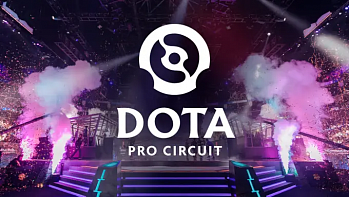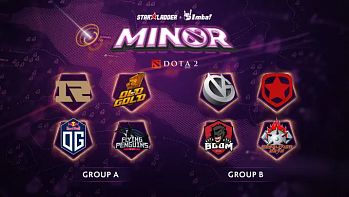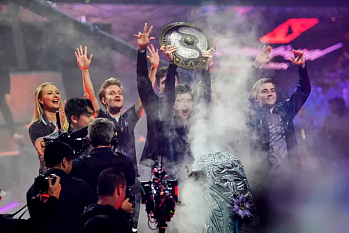The competitive Dota 2 has always been a center of attention for players and fans alike, attracting players with its unique format and team battles. Back in 2017, Valve introduced the Dota Pro Circuit (DPC) to make this world even more exciting and predictable. This system was created to make the path to The International more transparent and fair. But how has this system evolved over time? What were the challenges and limitations that teams and organizers faced? And finally, why did Valve decide to close the DPC, returning to the roots of competitive Dota 2? Read about it in the material of Telecomasia.net.
Bet on Esports with 1xBetIn this article we'll take a look at the history of the Dota Pro Circuit, review its development, problems and limitations, and talk about the reasons that led to the end of this system. We'll also take a look at the exciting events and accomplishments of teams in the DPC and learn about Valve's plans for the future of competitive Dota 2.
DPC History
2017: the beginning of a new era

The year 2017 marked the introduction of the Dota Pro Circuit (DPC). This system was created by Valve to make competitive Dota 2 more structured and fair. Until that point, the participants of The International had been determined mainly by Valve, and invitations created much confusion for teams and players.

DPC presented a new approach. It incorporated a number of majors and minors held around the world and awarded points to teams based on their performance. These points determined who would get a direct invite to The International and who would be forced to play through qualifiers.
2018-2019: OG dominance and balance

The early years of DPC also witnessed the dominance of OG team. They won The International 2018 and 2019, creating a sense of imbalance in the system. Other teams felt unable to compete with this powerhouse.
There were also difficulties due to the limited number of slots at the main event depending on the region. This meant that many talented teams did not get a chance to prove their worth.
Bet on Esports with 1xBet2020-2022: changes and adaptations
The DPC system continued to evolve. In 2020, COVID-19 affected the competition, and Valve was forced to adapt DPC to the new reality. Competitions switched to an online format, also affecting the dynamics of the events.
On top of that, tournament qualification and slot allocation systems became increasingly complex and strategic, and teams were forced to adapt to the everchanging rules.
2023: the end of the DPC and new horizons
Finally, in September 2023, Valve announced that the DPC would end after the current season. This decision created many questions and discussions in the Dota 2 community. Why did Valve decide to end the DPC, and what does the future of competitive Dota 2 hold?
Bet on Esports with 1xBetChallenges and limitations of the DPC
While the Dota Pro Circuit (DPC) was designed to make the Dota 2 competitive scene more fair and transparent, it also created its own set of challenges and limitations that affected the cybersports. Let's take a look at some of them.
Sameliness and a rigid schedule
The DPC system introduced a rigid schedule for teams and players. One after another, major after major, minor after minor - the teams were forced to follow the schedule and participate in all of these tournaments. This often led to players getting exhausted and spectators getting bored. Instead of having variety in schedules and competition formats, many tournaments started to look samey.
Limitations caused by COVID-19
The constraints created by the COVID-19 pandemic also affected the DPC. Competitions switched to an online mode, which affected the atmosphere and dynamics of the events. These changes also created additional challenges for teams and organizers as they started facing problems with internet connection, time zone differences and other issues typical of the online format.
Bet on Esports with 1xBetLimited regional slots
Another challenge the teams faced was the limited regional slots at the main competitions. Each region had a predetermined number of slots. It created suspense and the teams had to compete for the right to represent their region. Sometimes talented teams were left out of tournaments despite their potential.
The competitive pressure within the DPC was immense. Teams had to constantly deliver high scores to maintain their position in the rankings and have a chance to qualify for The International. This put extra stress on players and could affect their physical and psychological well-being.
Lack of diversity
Over time, the structure of the DPC became less diverse and interesting. Tournament organizers felt the need to meet Valve's strict requirements, and it felt like some of the magic that made Dota 2 so appealing to players and spectators was lost. Many teams and spectators missed the more creative and diverse tournaments that were popular before the introduction of DPC.
Interesting moments in the history of the DPC
The Dota Pro Circuit (DPC) has had many interesting and exciting events over the years. Let's take a look at some of them that have left the biggest mark in DPC history.
Bet on Esports with 1xBetExciting Grand Final OG vs. PSG.LGD
The Dota Pro Circuit has given us plenty of incredible grand finals, intense battles, and epic confrontations. The final series of The International 2018 between PSG.LGD and OG is one of those moments in DPC history. This series ended on the fifth decisive map won by OG, making a historic reversal and becoming the tournament champions.
Team Spirit victory at TI10
Team Spirit's incredible journey to The International 10 stands out in Dota 2 Pro Circuit history. After starting the group stage with two losses, the team did not give up and demonstrated an incredible fighting spirit. In the final standings, they took 4th place and secured their participation in the upper bracket of the main stage of the tournament.
The real test was the grand final of the tournament, where Team Spirit faced the favorite PSG.LGD. The players won the first two maps on their way to victory, but the Chinese team evened the score. During the decisive fifth map, Team Spirit put on an amazing performance and emerged victorious, becoming the champions of The International 10.
Bet on Esports with 1xBetA curious end of the DPC Season: Why Virtus.pro was left out of TI11
The end of the DPC season always brings excitement and anticipation of invitations to The International, but something incredible happened in the 2021/2022 season. Valve didn't give their invitation to TI 11 to Virtus.pro, one of the most famous teams in the world of Dota 2.
According to the official Dota 2 website, Virtus.pro was one point ahead of Fnatic in the DPC rankings. However, a closer look reveals that Valve chose to round the decimal fractions in the table to whole numbers, always rounding them down. Fnatic received an invitation precisely because of this unusual rounding method, even though Virtus.pro was ahead by 0.055 points according to an accurate calculation.
A new page in Dota 2 history
With the end of the Dota Pro Circuit, Valve is turning a new page in the history of the competitive Dota 2 scene. One of the main goals is to return to the elements that made the game so appealing to players and viewers. This involves finding new approaches to tournaments, competition formats, and interacting with teams and fans.
Valve is going to actively interact with the community to get back to the roots and create a better Dota 2 competitive scene. An important aspect of the future of Dota 2 is considering the opinions of players, fans, and tournament organizers. This will create a more open and inspiring environment for everyone involved.
Bet on Esports with 1xBet




